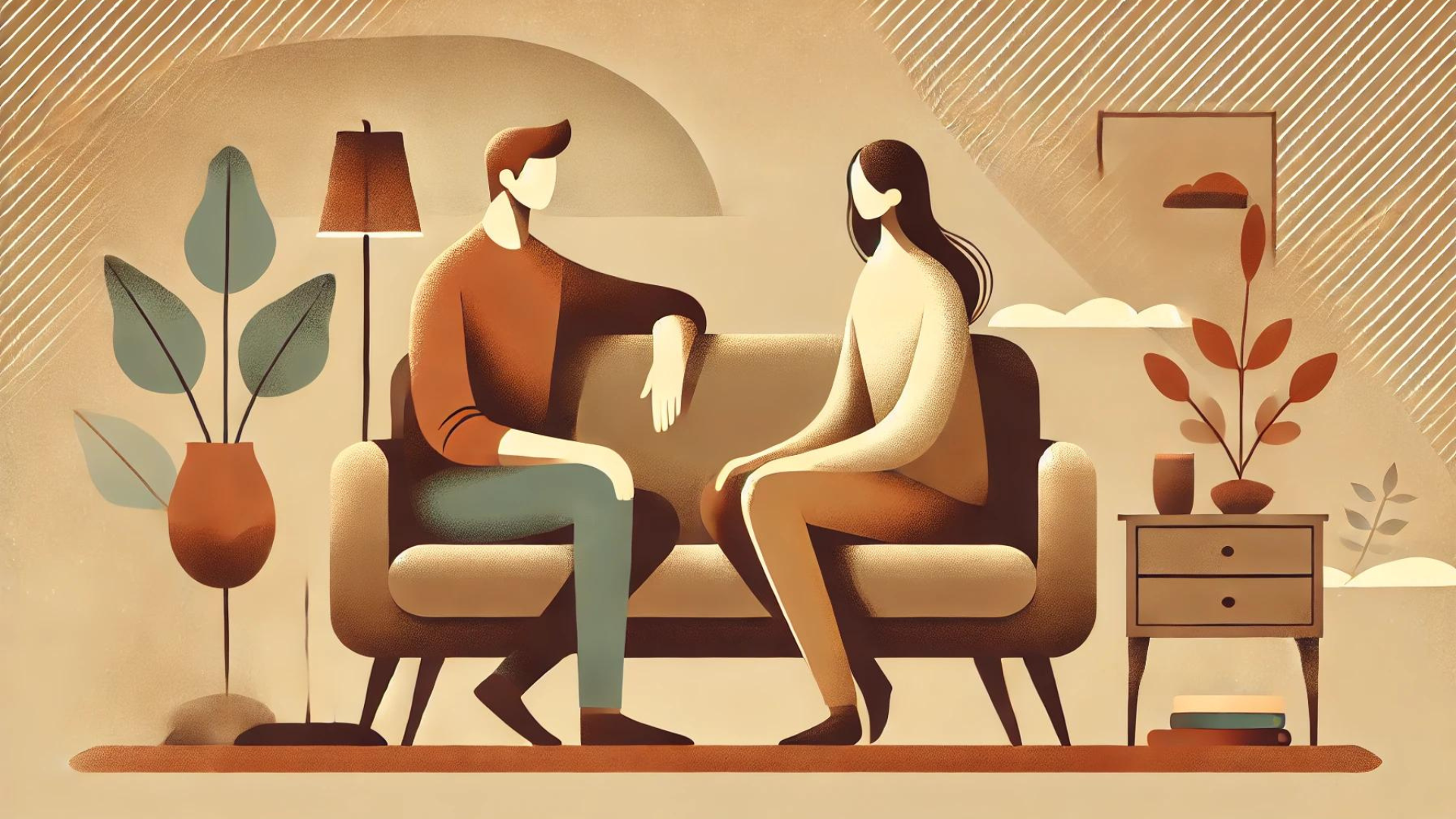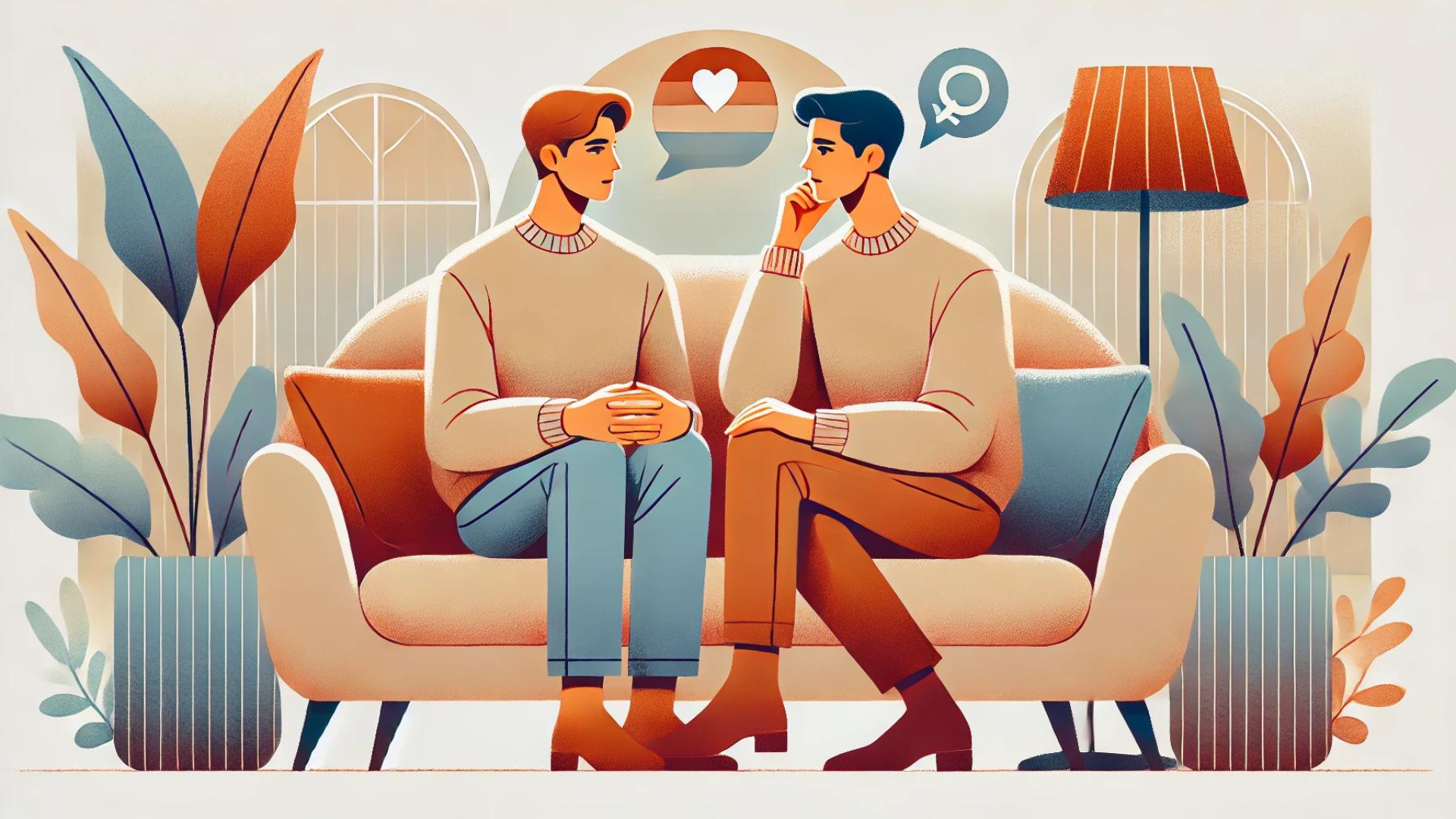Sexual Rejection in Long-term Relationships
A stylised illustration featuring a diverse couple sitting together on a couch in a cozy living room, engaged in an emotional and meaningful conversation. The minimalist design and warm colours emphasise the empathy and understanding shared between the partners.
Introduction
Sexual rejection in marriage and long term partnered relationships is a delicate and complex issue that can have profound effects on both partners and the relationship as a whole. When one partner turns down the other’s sexual advances, it often triggers a cascade of emotions that can be difficult to navigate. These emotions can include hurt, frustration, anger, and decreased self-esteem, which, if left unaddressed, can erode the foundation of the relationship. This article explores the impact of sexual rejection, the role of low sexual self-esteem, and the common emotional response of anger, offering insights into how couples can manage these challenges with empathy and effective communication.
There are many factors that impact sexual desire, response and motivation to consider, and most other considerations are beyond the scope of this article. Mental health conditions such as PTSD and depression can also impact on the relationship dynamic and these issues are explored in more depth in these articles: PTSD, Emotions, and Sexual Dysfunction and the Role of the Dual Control Model.
The Impact of Sexual Rejection
Sexual rejection in a marital relationship is closely associated with decreased relationship satisfaction and increased negative emotions. When sexual advances are consistently rebuffed, it can lead to feelings of inadequacy and rejection, which may, in turn, create a cycle of avoidance and further relationship distress (Byers, 2005). The emotional toll of sexual rejection can be significant, leading to a breakdown in communication, increased emotional distance, and a deterioration in overall intimacy between partners.
Repeated sexual rejection can create an environment where one or both partners begin to avoid initiating sexual encounters, fearing further rejection. This avoidance can create a negative feedback loop, where the lack of sexual connection exacerbates feelings of dissatisfaction and emotional distance, further diminishing the quality of the relationship (Kim, Muise, Sakaluk, Rosen, & Impett, 2020).
Low Sexual Self-Esteem and Its Role in Rejection
Low sexual self-esteem is another critical factor that contributes to both experiencing and initiating sexual rejection. Individuals with low sexual self-esteem often struggle with anxiety about their sexual performance, negative body image, and fear of intimacy, which can make them more likely to reject sexual advances (Meston & Buss, 2007). This rejection, in turn, reinforces their low self-esteem, creating a vicious cycle that is difficult to break.
When one partner has low sexual self-esteem, they may interpret sexual rejection as a confirmation of their insecurities, leading to further withdrawal from sexual and emotional intimacy. This withdrawal can deepen the divide between partners, making it increasingly challenging to restore a sense of connection and mutual satisfaction in the relationship (Muise, Stanton, Kim, & Impett, 2016).
Anger as a Common Response
Anger is a common emotional response to sexual rejection, particularly among men. This anger often stems from feelings of inadequacy, frustration, and perceived threats to masculinity (Štulhofer, Ferreira, & Landripet, 2014). Men may interpret sexual rejection as a personal failure or a sign that they are not valued or desired by their partner, leading to feelings of anger and resentment.
This anger can manifest in various ways, including emotional outbursts, passive-aggressive behavior, or further withdrawal from the relationship. The anger response can be particularly damaging as it may create an atmosphere of hostility and resentment, making it difficult for the couple to communicate openly and work through the underlying issues that contribute to the rejection (Reis, Lemay Jr, & Finkenauer, 2017).
Gender Differences in Responses to Rejection
Research indicates that men and women may respond differently to sexual rejection. Men are more likely to experience negative emotions, including anger, in response to rejection, while women are more likely to internalize the rejection, leading to decreased sexual self-esteem (Štulhofer, Ferreira, & Landripet, 2014). Women may interpret sexual rejection as a reflection of their desirability or attractiveness, which can exacerbate feelings of inadequacy and low self-worth.
These gender differences highlight the importance of understanding and addressing the unique ways in which sexual rejection impacts each partner. For men, addressing feelings of anger and perceived threats to masculinity may be crucial, while for women, bolstering sexual self-esteem and addressing body image concerns may be more important.
Stylised illustration of a couple sitting on a couch in a cozy living room, engaged in a heartfelt conversation, with body language showing empathy and connection.
The Cycle of Rejection and Anger
The interplay between rejection and anger can create a destructive cycle that further erodes the relationship. When a partner reacts to rejection with anger, it often leads to further avoidance and rejection by the other partner, perpetuating a cycle of hurt and emotional distance (Byers, 2005). This cycle can be challenging to break, particularly if both partners become entrenched in their respective roles as the "rejector" and the "rejected."
Breaking this cycle requires a concerted effort to understand and address the underlying issues that contribute to rejection and anger. This may involve open communication, empathy, and a willingness to work together to rebuild trust and intimacy in the relationship.
Coping Strategies for Couples
Effective communication and empathy are key strategies for breaking the cycle of rejection and anger in marriage. Couples need to create a safe space where they can openly discuss their feelings, fears, and insecurities without fear of judgment or reprisal (Kim, Muise, Sakaluk, Rosen, & Impett, 2020). This open communication allows both partners to better understand each other's needs and work together to find solutions that meet those needs.
In addition to communication, addressing underlying issues related to sexual self-esteem is crucial. This may involve individual therapy to address body image concerns, anxiety about sexual performance, or fear of intimacy. By improving their self-esteem, individuals can become more confident and secure in their sexual relationships, reducing the likelihood of rejection and the negative emotions that accompany it (Meston & Buss, 2007).
Conclusion
Sexual rejection in marriage is a complex issue that can significantly impact both partners and the overall quality of the relationship. Low sexual self-esteem and anger are common responses to rejection, and these emotions can create a cycle of hurt and distance that is difficult to break. However, with effective communication, empathy, and a commitment to addressing underlying issues, couples can work together to overcome these challenges and restore intimacy and satisfaction in their relationship.
References
Byers, E. S. (2005). Relationship satisfaction and sexual satisfaction: A longitudinal study of individuals in long‐term relationships. Journal of Sex Research, 42(2), 113-118.
Kim, J. J., Muise, A., Sakaluk, J. K., Rosen, N. O., & Impett, E. A. (2020). When tonight is not the night: Sexual rejection behaviors and satisfaction in romantic relationships. Personality and Social Psychology Bulletin, 46(10), 1476-1490.
Meston, C. M., & Buss, D. M. (2007). Why humans have sex. Archives of Sexual Behavior, 36(4), 477-507.
Muise, A., Stanton, S. C., Kim, J. J., & Impett, E. A. (2016). Not in the mood? Men under-(not over-) perceive their partner's sexual desire in established intimate relationships. Journal of Personality and Social Psychology, 110(5), 725.
Reis, H. T., Lemay Jr, E. P., & Finkenauer, C. (2017). Toward understanding understanding: The importance of feeling understood in relationships. Social and Personality Psychology Compass, 11(3), e12308.
Štulhofer, A., Ferreira, L. C., & Landripet, I. (2014). Emotional intimacy, sexual desire, and sexual satisfaction among partnered heterosexual men. Sexual and Relationship Therapy, 29(2), 229-244.


